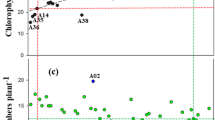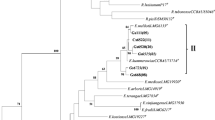Abstract
A study was conducted with the aim of evaluating the genetic diversity of alfalfa rhizobia isolated from volcanic soils in southern Chile and their ability to establish an effective symbiosis with alfalfa. Rhizobial strains isolated from nodules were identified and selected based on PCR analyses and acid tolerance. Symbiotic effectiveness (nodulation and shoot dry weight) of acid-tolerant rhizobia was evaluated in glasshouse experiments under acidic conditions. The results revealed that Sinorhizobium meliloti is the dominant species in alfalfa nodules with a high genetic diversity at strain level grouped in three major clusters. There was a close relationship (r 2 = 0.895, P ≤ 0.001, n = 40) between soil pH and the size of rhizobial populations. Representative isolates from major cluster groups showed wide variation in acid tolerance expressed on buffered agar plates (pH 4.5–7.0) and symbiotic effectiveness with alfalfa. One isolate (NS11) appears to be suitable as an inoculant for alfalfa according to its acid tolerance and symbiotic effectiveness at low pH (5.5). The isolation and selection of naturalized S. meliloti strains with high symbiotic effectiveness under acidic conditions is an alternative approach to improving the productivity of alfalfa and for reducing the application of synthetic fertilizers in Chile.


Similar content being viewed by others
References
Ballard RA, Charman A (2000) Nodulation and growth of pasture legumes with naturalized soil rhizobia. 1. Annual Medicago spp. Aust J Exp Agr 40:939–948
Ballard RA, Shepherd BR, Charman A (2003) Nodulation and growth of pasture legumes with naturalized soil rhizobia. 3. Alfalfa (Medicago sativa L.). Aust J Exp Agr 43:135–140
Barber LE (1980) Enumeration, effectiveness, and pH resistance of Rhizobium meliloti populations in Oregon Soils. Soil Sci Soc Am J 44:537–539
Biondi EG, Pilli E, Giuntini E, Roumiantseva ML, Andronov EE, Onichtchouk OP, Kurchak ON, Simarov BV, Dzyubenko NI, Mengoni A, Bazzicalupo M (2003) Genetic relationship of Sinorhizobium meliloti and Sinorhizobium medicae strains isolated from Caucasian region. FEMS Microbiol Lett 220:207–213
Bradic M, Sikora S, Redzepovic S, Stafa Z (2003) Genetic identification and symbiotic efficiency of an indigenous Sinorhizobium meliloti field population. Food Technol Biotech 41:69–75
Brockwell J (1963) Accuracy of a plant-infection technique for counting populations of Rhizobium trifolii. Appl Microbiol 11:377–383
Brockwell J, Pilka A, Holliday RA (1991) Soil pH is a major determinant of the numbers of naturally ocurring Rhizobium meliloti in non-cultivated soils in central New South Wales. Aust J Exp Agr 31:211–219
Campillo R, Urquiaga S, Pino I, Montenegro A (2003) Estimación de la fijación biológica de nitrógeno mediante la metodología de 15N. Agr Téc (Chile) 63:169–179
Carelli M, Gnocchi S, Fancelli S, Mengoni A, Paffetti D, Scotti C, Bazzicalupo M (2000) Genetic diversity and dynamics of Sinorhizobium meliloti populations nodulating different alfalfa cultivars in Italian soils. Appl Environ Microbiol 66:4785–4789
Carvalho MCS, Raij BV (1997) Calcium sulphate, phosphogypsum and calcium carbonate in the amelioration of acid subsoils for root growth. Plant Soil 192:37–48
Cheng Y, Watkin ELJ, Howieson JG, O’Hara GW (2005) Root and root hair mechanisms that confer symbiotic competence for nodulation in acidic soils within Medicago species: a holistic model. Aust J Exp Agr 45:231–240
Dilworth MJ, Tiwari RP, Reeve WG, Glenn AR (2000) Legume root nodule bacteria and acid pH. Sci Prog 83:357–389
Eardly BD, Materon LA, Smith NH, Johnson DA, Rumbaugh MD, Selander RK (1990) Genetic structure of natural populations of the nitrogen-fixing bacterium Rhizobium meliloti. Appl Environ Microbiol 56:187–194
Evans PM, Howieson JG, Nutt BJ (2005) Increased yield and persistence of several annual medic species and Medicago sativa by inoculation with selected strains of Sinorhizobium meliloti and S. medicae. Aust J Exp Agr 45:217–224
Gandee CM, Harrison SP, Davies WP (1999) Genetic characterization of naturally occurring Rhizobium meliloti populations and their potential to form effective symbioses with alfalfa. Lett Appl Microbiol 28:169–174
Garau G, Reeve WG, Brau L, Deiana P, Yates RJ, James D, Tiwari R, O’Hara GW, Howieson JG (2005) The symbiotic requirements of different Medicago spp. suggest the evolution of Sinorhizobium meliloti and S. medicae with hosts differentially adapted to soil pH. Plant Soil 276:263–277
Hardarson G, Atkins C (2003) Optimising biological N2 fixation by legumes in farming systems. Plant Soil 252:41–54
Howieson JG, Ewing MA (1986) Acid tolerance in the Rhizobium meliloti-Medicago symbiosis. Aust J Agr Res 36:55–64
Howieson JG, Ewing MA, D’Antuono MF (1988) Selection for acid tolerance in Rhizobium meliloti. Plant Soil 105:179–188
Howieson JG, Loi A, Carr SJ (1995) Biserrula pelecinus L––a legume pasture species with potential for acid, duplex soils which is nodulated by unique root-nodule bacteria. Aust J Agr Res 46:997–1009
Howieson JG, Malden J, Yates RJ, O’Hara GW (2000a) Techniques for the selection and development of elite inoculant strains of Rhizobium leguminosarum in Southern Australia. Symbiosis 28:33–48
Howieson JG, Nutt B, Evans P (2000b) Estimation of host-strain compatibility for symbiotic N-fixation between Rhizobium meliloti, several annual species of Medicago and Medicago sativa. Plant Soil 219:49–55
Jebara M, Mhamdi R, Aouani ME, Ghrir R, Mars M (2001) Genetic diversity of Sinorhizobium populations recovered from different Medicago varieties cultivated in Tunisian soils. Can J Microbiol 47:139–147
Jensen ES, Hauggaard-Nielsen H (2003) How can increased use of biological N2 fixation in agriculture benefit the environment? Plant Soil 252:41–54
Mora ML, Cartes P, Demanet R, Cornforth IS (2002) Effects of lime and gypsum on pasture growth and composition on an acid Andisol in Chile, South America. Commun Soil Sci Plan 33:2069–2081
O’Hara GW, Yates RJ, Howieson JG (2002) Selection of strains of root nodule bacteria to improve inoculant performance and increase legume productivity in stressful environments. In: Herridge D (ed) Inoculants and nitrogen fixation of legumes in Vietnam, vol 109e. ACIAR Proceedings, Canberra, p 75
Richardson AE, Viccars LA, Watson JM, Gibson AH (1995) Differentiation of Rhizobium strains using the polymerase chain reaction with random and directed primers. Soil Biol Biochem 27:515–524
Rickert AA, Soria MA, Correa OS (2000) The adaptive acid response in Mesorhizobium sp. World J Microbiol Biotechnol 16:475–480
Sebbane N, Sahnoune M, Zakhia F, Willems A, Benallaoua S, de Lajudie P (2006) Phenotypical and genotypical characteristic of root-nodulating bacteria isolated from annual Medicago spp. in Soummam Valley (Algeria). Lett Appl Microbiol 42:235–241
Segundo E, Martínez-Abarca F, van Dillewijn P, Fernández-Lopez M, Lagares A, Martínez-Drets G, Niehaus K, Pühler A, Toro N (1999) Characterisation of symbiotically efficient alfalfa-nodulating rhizobia isolated from acid soils of Argentina and Uruguay. FEMS Microbiol Ecol 28:169–176
Toma M, Saigusa M (1997) Effects of phosphogypsum on amelioration of strongly acid nonallophanic andosols. Plant Soil 192:49–55
Vincent JM (1970) A manual for the practical study of root-nodule bacteria. Blackwell, Oxford
Yanagi M, Yamasato K (1993) Phylogenetic analysis of the family Rhizobiaceae and related bacteria by sequencing of 16S rRNA gene using PCR and DNA sequencer. FEMS Microbiol Lett 107:115–120
Zhao Z, Williams SE, Schuman GE (1997) Renodulation and characterization of Rhizobium isolates from cicer milkvetch (Astragalus cicer L.). Biol Fert Soils 25:169–174
Acknowledgements
The authors thank to staff members at the Centre for Rhizobium Studies, Murdoch University (CRS) for valuable advice and Regina Carr and Jason Terpolilli for their technical assistance. We are also grateful to Takehiko Kenzaka from Graduate School of Pharmaceutical Sciences at Osaka University (Japan) for assistance in genetic analysis. This research was partially supported by an overseas travel grant provided by Fundación Andes (Chile) C-13755(28).
Author information
Authors and Affiliations
Corresponding author
Rights and permissions
About this article
Cite this article
Langer, H., Nandasena, K.G., Howieson, J.G. et al. Genetic diversity of Sinorhizobium meliloti associated with alfalfa in Chilean volcanic soils and their symbiotic effectiveness under acidic conditions. World J Microbiol Biotechnol 24, 301–308 (2008). https://doi.org/10.1007/s11274-007-9471-y
Received:
Accepted:
Published:
Issue Date:
DOI: https://doi.org/10.1007/s11274-007-9471-y




